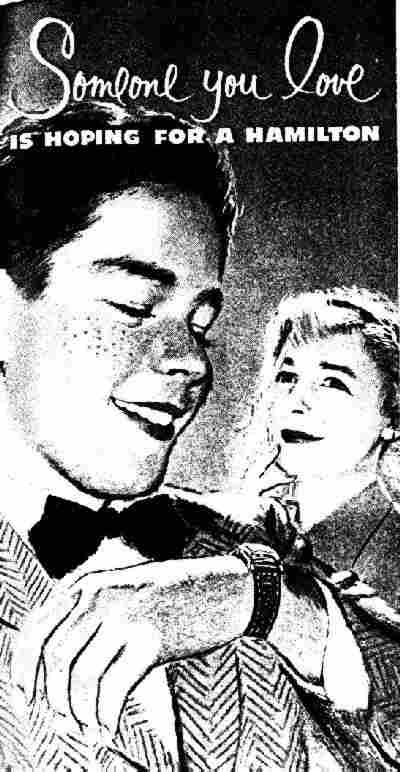
Fihure 1.--This advertisement for Hamilton watches appeared in a February 1951 American magazine. Watches were considered appropriate graduation presents. |

|
One sign that a 19th century boy was growing up was when he received his first pocket watch and fob. Eatches were still expensive though so usually only boys from affluent families had them and they might only be worn for formal occasions, especially by younger boys. Watches have in the 20th century probably been the most common jewlry or accessory worn by boys. Boys in the 1960's began wearing wrist watches much more than before. One of the most popular bands was a Speidel "Twistoflex". A lot of boys wore those wide-band
watches, that went into the 70's. RECENTLY, watches are really back strong, I have seen some of the wide-band watches come back. But mainly they are still the black
watches. (Digital and analog).
Watches were rather expensive until the 1970s and only a minority of boys wore them to school or while playing after school. They were something a little special. They were often considered an excellent graduation present.
Men and boys have orn boy pocket watches and wrist watches. Pocket watches were a necesity for any man of substance in the 19th century, especially the late 19th century. Because of the cost, they were not given to boys until they were well into thir teen years at the deraliest. Interestingly, the shift from three piece suits to two piece suits and then to shirt sleeves and casual wear is a factor in the changing popularity of pocket and wrist watches.
This is a new topic for HBC and we are just beginning to acquire information on it. Watches were developed from early clocks in the late 15th century. These early watches, however, were bulky and could not be carried in pockets and they were not very accuate. Pocket watches appeared in the mid-17th century. The key technical developments making the modern watch accurate and feasible did not come together until the befiining of the 18th century. Mass manufacturing processes were developed in the mid-19th century. HBC needs to refine the manufacturing dates as they would help to date images. Obviously you would not give an expensive hand-made watch to a small child. HBC believes that about the 1880s that pocket watches began to appear at prices that they may have been given tio children. They were the preferred time piece of men until wrist watches began to replace them in the 1920s. Boys would not receicve them, however, until they were outfitted in their first adult-looking suit.
I'm not sure when wrist watches first appaeredm but they began to become popular in the 1920s. They were more commnly worn by boys then pocket watches, but were not widely worn by boys until the 1960s. br>
A 1951 advertisement for Hamilton watches read, "At last he has graduated--to a Hamilton. Whay a proud moment. And how important in the years to come that you have given that someone you love the watch world famous for accuarcy." The ad then goes into great detail about the watch itself.
One of the most popular bands was a Speidel "Twistoflex". A lot of boys wore those wide-band watches, that went into the 70's. RECENTLY, watches are really back strong, I have seen some of the wide-band watches come back. But mainly they are still the black
watches. (Digital and analog).
I believe that wrist watches were initially more poular for boys than girls, but I can't substatiate that yet.
I believe wrist watches were most popular in Ameica, This is because Americans are generally more open to technological change than Europeans. Also American was generally more affluent than Europeans.
I'm not sure when wrist watches first appeared or when boys started wearing them. Through the 1950s, most boys did not wear their watches to school. Boys in the 1960's began wearing wrist watches much more than before. Any review of school pictures provide a good assessment of how common watch wearing was.
America the early 1940s: Only one boy in this elementary school class wore a wrist watch. It looks to be a class of about 4th graders, 10-year olds. Am older boy, serving as a Saftey Patrol, raises the flag, but he also does not wear a wrist watch.
Navigate the Boys' Historical Clothing Web Site:
[Return to the Main jewelry page]
[Introduction]
[Activities]
[Biographies]
[Chronology]
[Cloth and textiles]
[Clothing styles]
[Countries]
[Topics]
[Bibliographies]
[Contributions]
[FAQs]
[Glossaries]
[Images]
[Links]
[Registration]
[Tools]
[Boys' Clothing Home]
